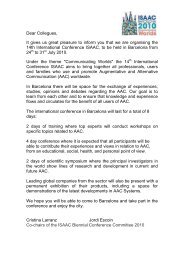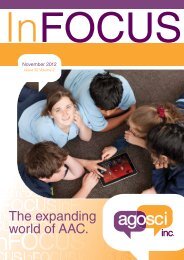May 2008 Edition - agosci
May 2008 Edition - agosci
May 2008 Edition - agosci
You also want an ePaper? Increase the reach of your titles
YUMPU automatically turns print PDFs into web optimized ePapers that Google loves.
ccommunicationo m m u n i c a t i o nppartnersa r t n e r sA Communication Partner Reflects onSuccessMeg Irwin & Helen Curtismirwin.crc@scopevic.org.auIntroductionMany attendant care workers (ACWs) are excellentcommunication partners for the people with communicationneeds with whom they work. Meg, a speech pathologist,interviewed Helen, one such ACW, for this article. Most of thewords are Helen’s as she refl ected on her experiences workingwith Alice.AliceAlice is a 48 yr old woman born in northern Europe whereall her birth family remain. She and her then partner migratedto Australia when she was about 18 years old. In Australia,Alice had two more partners and had four children. She was 37when she had an hypoxic brain injury after a benzodiazepamand tricyclic drug overdose in 1996. She now has only veryoccasional visits from some of her children. She lived in a ruralnursing home from 1996 until 2003 when she was moved to thelocked psychiatric unit.This residential unit is for people with acquired brain injuriesand behaviour deemed unmanageable in mainstream facilities.In this unit, nursing staff give medication and providepersonal care such as showering, dressing, feeding, andcontinence management. Other aspects of life for residents,such as community access and rehabilitation, are generallyleft to therapists and Attendant Care Workers who are fundedminimally and separately from the ward program.When Alice came to the unit, a small amount of speech,occupational and physio therapy time and 15 hours per weekof attendant care were funded by the Slow to Recover Program[1].When Meg met Alice in mid 2003, Alice did not use speech anddid not appear to understand speech or pictures. She could notmove her body or legs and had little control or use of her arms.At times she would vocalise loudly and grimace. She wouldclap her hands repeatedly and cry out “no no no no” or makea rasping growling sound. We thought the vocalisations wereassociated with fear or discomfort but we were not sure. Alicefrequently regurgitated food. No medical cause for this couldbe found. She chewed her clothing and ate and smeared bodilysubstances. Alice would briefl y look at bright objects and didnot visually scan. She opened her mouth to food and seemed toenjoy eating. Sometimes, she seemed to calm when there wasmusic playing and things were otherwise still and quiet.HelenHelen has now worked with Alice for more than four years. Inthat time she has seen change. Helen rejoices in both the gainsAlice seems to have made and in the relationship that Helenexperiences with her:I knew it would be enjoyable. I knew it would make a bigdifference but it’s huge. It’s huge! And it’s such a tinything, but in the scheme of things it’s massive! It’s hugeto have her look at you and actually look at you as a real– in a real way, you know. That she’s looking at your face.Or you make her noise and she makes it back. Or youcome in and you say hello and she makes a little – I canonly interpret it as a – you know – a sort of hello back.It’s a gentle sound. It’s a sort of warm sound. It’s um –it’s responsive. You know it’s - timing wise - it’s sort ofcorrect. That’s the way it appears to me anyway. I mean Icould – God knows – I could be right off the mark. But- genuinely - I don’t feel like I am.In this Meg sees four things that she thinks make Helen agreat communication partner for Alice and others who do notcommunicate intentionally:• Helen wishes for relationship with Alice• Helen is willing to stay with the uncertainty of what (or if)Alice means• Helen trusts her feeling of what is happening• Helen has fi ne-grained observational skills (Helen’sinformation about Alice’s abilities has been used to developpersonal communication dictionaries, sensory guidelines,and other protocols to enable others to support Alice’scommunication and participation).A Successful Communication PartnerListening to Helen’s refl ections about her work with Alice, thesuccess of a communication partner seems to rely upon threethings:• The communication partner’s interaction with theenvironment of the person with communication needs• The communication partner’s behaviours to facilitatecommunication• The attitude of the communication partner to the personwith communication needsThe Communication Partner’s Interaction With The EnvironmentOf The Person With Communication NeedsEffective work was assisted by:• Adequate physical access and aids;they’ve changed the two front wheels [on the wheelchair]…it has made it a pleasure to take her out of the unitagain…• Having the knowledge and skills to operate successfullywithin the environment;My confi dence… has grown so much…getting to knowthe clients – getting to know everybody – getting to knowhow you need to react to other people … you’ve got tohave your wits about you. I mean the nature of the unit is11





